Mold in the bathroom. Effective remedies for fungus in the bathroom
Mold in the bathroom at the seams of the tiles is a serious problem that affects human health. To remove this unpleasant problem, certain chemicals and folk methods are used. In the bathroom, due to various reasons, black mold sometimes forms on the seams of the tiles. This is due to the fact that favorable conditions have been created in this room for the reproduction of pathogenic microorganisms.
The main reasons for the appearance of the fungus are: high humidity, lack of sunlight, insufficient ventilation, sudden changes in temperature.
Mold on tiles
 If the fungus in the bathroom appeared on the facing tiles, it is easy to deal with it. If the ventilation in the bathroom is sufficient, the fungus may not reappear. It is necessary to clean the surface of the tile, degrease it and dry it thoroughly. Then the surface is treated with a solution of vinegar; after the tile dries, a strong soda solution is applied.
If the fungus in the bathroom appeared on the facing tiles, it is easy to deal with it. If the ventilation in the bathroom is sufficient, the fungus may not reappear. It is necessary to clean the surface of the tile, degrease it and dry it thoroughly. Then the surface is treated with a solution of vinegar; after the tile dries, a strong soda solution is applied.
Vinegar can be replaced with chlorine solution, copper sulfate or hydrogen peroxide. After applying the soda slurry to the surface, it will take time for the alkali to actively interact with the mold. It is better to carry out such a procedure at night. After removing mold from the walls, it is necessary to pay attention to the reasons that provoke its appearance. If possible, install better ventilation or a larger window, regularly wipe the tile surface after condensation has not formed.
Mold between seams
Eliminating mold in the bathroom between the seams of the tiles is much more difficult. At first, it's a good idea to try cleaning them with a baking soda solution and an old toothbrush. After drying the treated seams, one can judge the depth of the fungal infection. If the measures taken are not enough, a mini-cosmetic repair will be required, which consists in grouting the joints between the tiles using new materials. They are pre-treated with a solution of copper sulfate. After all the necessary measures have been taken, the seams are rubbed with a sealant-based product.
The seams should be rubbed with a solution that contains an antiseptic. This way you can avoid the recurrence of mold.
How to get rid of fungus on the ceiling
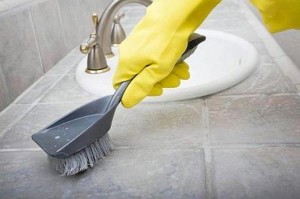 To remove black mold in the bathroom on the ceiling, drastic measures are needed. The ceiling must be cleaned of plaster, then primed again using an antiseptic primer. Then the dried primer layer should be treated with a liquid penetrating primer, which will improve the adhesion of the ceiling surface. Then, when this layer dries out, the irregularities are leveled with acrylic putty. Then the surface is sanded and primed, after which it can be painted, whitewashed or decorated in other ways.
To remove black mold in the bathroom on the ceiling, drastic measures are needed. The ceiling must be cleaned of plaster, then primed again using an antiseptic primer. Then the dried primer layer should be treated with a liquid penetrating primer, which will improve the adhesion of the ceiling surface. Then, when this layer dries out, the irregularities are leveled with acrylic putty. Then the surface is sanded and primed, after which it can be painted, whitewashed or decorated in other ways.
A faster and more economical method is also used - the ceiling is treated with bleach. The surface is impregnated with a solution of this substance, then dried well. But this method is short-lived. In the presence of conditions favorable for the development of the fungus, it reappears.
We eliminate mold using industrial means
You can get rid of the fungus both with folk remedies and with the help of special preparations that are designed to combat this phenomenon. These preparations must be treated with the entire room, including the area under plumbing fixtures. But the key task of combating this phenomenon is to identify and eliminate main reason the appearance of mold.
It is possible to eliminate this problem with the help of antifungal drugs. But before you clean the mold in the bathroom, you should follow the rules of pre-treatment of the surface. The surface layer is removed, then it is processed with a building hair dryer. It is not recommended to include water during the processing period. The air must be dry. Then, special antifungal agents are applied between the seams of the tiles. Do not forget about a protective mask and rubber gloves so that active chemical compounds do not harm your health.
There are many ways to get rid of the phenomenon of mold in the bathroom. Among them are:
- copper sulphate solution;
- a combination of water and concentrated chlorine solution;
- industrial chemical antifungals.
With the help of copper sulphate, it is possible to remove mold in the bathroom, both from the surface of the tile and between the seams. It is easy to use, but you need to remember about safety measures, as it is poisonous. The substance is diluted based on the information in the instructions (one hundred grams of the substance is taken per 10 liters of water). It is applied to the surface of the tile with a sponge, vitriol is applied between the seams with a brush or a toothbrush. In places of severe damage, spread with a thick layer.
Then you should wait a few hours, wash the surface well and dry, then ventilate the room.
Another remedy to remove mold between seams is chlorine bleach. A solution is prepared, applied between the seams. It doesn't need to be washed off. After processing, the room must be ventilated. To industrial means that help to defeat mold, it is worth including the drug Renogal. It effectively removes mold from the surface of the tile and between the seams.
Getting rid of mold using folk methods
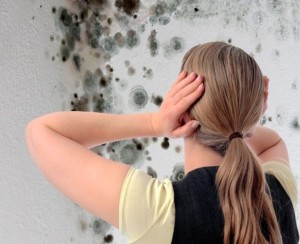 In addition to traditional fungicidal agents, folk methods are used to eliminate the problem. The use of chemicals is not suitable for those people who are susceptible to substances in their composition. In this case, it is good to try effective folk ways who have performed well. Among them is a solution of baking soda slaked with vinegar. A slurry of soda is made, applied between the seams, poured with vinegar on top. After the resulting foam settles, the surface is washed and dried.
In addition to traditional fungicidal agents, folk methods are used to eliminate the problem. The use of chemicals is not suitable for those people who are susceptible to substances in their composition. In this case, it is good to try effective folk ways who have performed well. Among them is a solution of baking soda slaked with vinegar. A slurry of soda is made, applied between the seams, poured with vinegar on top. After the resulting foam settles, the surface is washed and dried.
As a rule, the problem of fungus in the bathroom is solved only in complex ways. So, it is very important to create unfavorable conditions for the spread of the fungus, namely, to take care of good ventilation of the room, reduce the level of humidity, prepare special means a.
Key points for fighting fungus in the bathroom
The very first thing you need to pay attention to when mold appears in the bathroom is this is the state of plumbing equipment: pipes, taps, bathroom. If a leak is detected, it is very important to make repairs, which will prevent the appearance of condensate in the future.
Having got rid of problems with plumbing, it is necessary to clean the walls affected by the fungus, as well as the ceiling from plaster or paint. Since the mycelium has the ability to penetrate enough great depth, it is very important, in addition to processing with special means, to mechanically clean the damaged surface.
The next step in the fight against fungus in the bathroom is to dry the room, which will require special equipment - heaters or heat guns. It is very important to ensure uniform heating in the room.
Only after repair work has been carried out in the room, it is possible to start treating surfaces (walls, ceiling, junctions of the bathtub and sink with the wall, etc.) with antiseptic agents in order to prevent the appearance of fungus in the future. Particular attention during processing must be given to places located in close proximity to pipes and taps.
In addition to the use of agents that prevent the reproduction of black fungus, it is necessary to carry out another preventive measure - to treat the surface with substances that prevent the penetration of moisture into the interior. It is very important to remember that all materials used for construction and finishing works (including paint) must have moisture-resistant characteristics.
When purchasing finishing materials and means for processing premises, be sure to check with the sales assistant the degree of their moisture resistance
Folk remedies for mold in the bathroom
In addition to store funds, there are several folk recipes, which are also effective against fungus in the bathroom. Among them:
- about treating the affected surface with creosote dissolved in alcohol, ether or water. When working with this solution, it is necessary to take care of personal protective equipment - the presence of a mask and gloves;
- surface treatment with a solution of acetic acid, boric acid, hydrogen peroxide or soda. Each of the funds in a certain ratio (usually at the rate of 1 to 10) must be dissolved in water. A solution of hydrogen peroxide, boric acid, vinegar, water in a ratio of 2:1:2:4 is considered one of the most effective in the fight against fungus. Before applying it to the surface with a sponge, the solution must be heated to 50 or 70 degrees, after which it must be left on the affected surface for a certain amount of time. Then the surface is washed with warm water.
Chlorine-containing products guarantee getting rid of the fungus. That is why bleach treatment has its wide application in various institutions. So, bleach can also be used to clean a home, since it often contains a component necessary for such a case. Do not forget that during the work, hands must be in gloves!
Tea tree oil is also used to fight fungus. So, you need to dilute 2 teaspoons of oil with two glasses of water, after which the affected surface should be treated with a spray bottle. It is best to repeat the procedure several times.
Prevention
The most reliable way to deal with fungus in the bathroom is prevention. So, eliminating the causes of mold is many times easier than fighting the fungus that has already appeared. That is why it is necessary to constantly follow certain rules.
It is better to use a balcony or other room to dry clothes, as wet clothes also contribute to an increase in humidity levels.
Mold in the bathroom is a common occurrence that many people have probably encountered. There are many reasons for its appearance, but the main one is high humidity. Of course, her appearance will please few people, she not only spoils the appearance of the walls of the room, but has a harmful effect on health. Therefore, as soon as the first fungal stains began to appear on the tiles in the bathroom, they must be immediately treated with special means. And how to clean mold on tile joints and what is used for this, we will tell in more detail.
Causes of mold
Many people often ask - why does a fungus often occur in the bathroom? After all, it seems that everything is done to ensure cleanliness and order - cleaning, washing floors and walls, using special detergents. And fungal stains still appear again and again, and it is not possible to clean them. First of all, it is worth finding out the causes of mold:
- it is possible that the relevant standards were not observed during the installation of the tiles and mistakes were made;
- poor ventilation in the room;
- low temperature in the bathroom;
- poor-quality cleaning of the premises;
- high level of humidity;
- carrying out constant water procedures - drying things, washing.
Often, mold spots appear on tile joints, which greatly spoil the aesthetic appearance of the room. But do not forget that the fungus has a serious impact on health and can cause serious consequences. Therefore, at the first detection of spots on the seams, it is immediately necessary to process. To remove, you can use a special primer antifungal mixture. The seams are thoroughly rubbed with a primer until the stains are completely removed. They can be covered with grout on the sealant.
In addition, the bath and bathroom after taking a bath or shower, washing, be sure to ventilate. To do this, you need to open the door. It is advisable to install a fan in the ventilation duct to blow the room. Due to this, moisture will quickly erode.
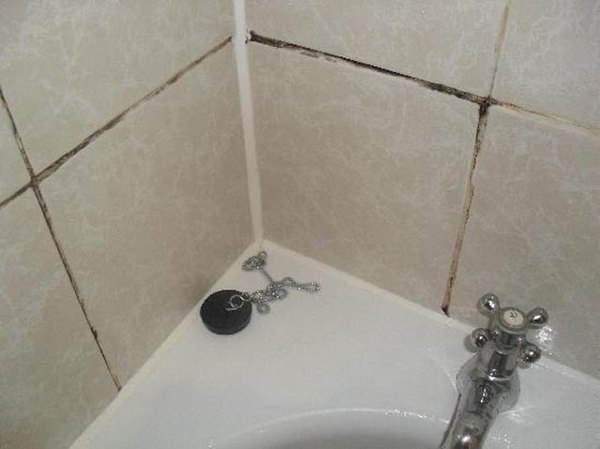
It is good if the room has a hot heated towel rail or radiator. If these elements are not available, then a heater can be installed there to heat the room. Also be sure to do the cleaning using detergents that protect the tiles from fungal and mold stains.

Locations of mold spots
We sort of figured out the reasons, now it’s worth finding out where spots of black or green fungus can appear. This will simplify the work and also save money for processing.
In the bathroom, fungal accumulations often appear in places:
- spots of black or green often fill the seams of the tiled floor;
- the fungus may appear in the corners of the room;
- at the joints of the walls;
- sometimes mold can be found in the shower, between the shelves, in any gaps of cabinets, walls.
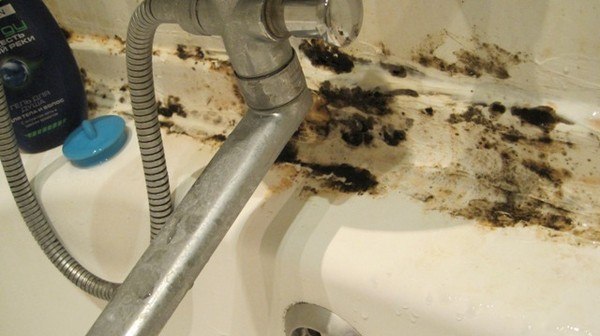 Mold around the faucet
Mold around the faucet 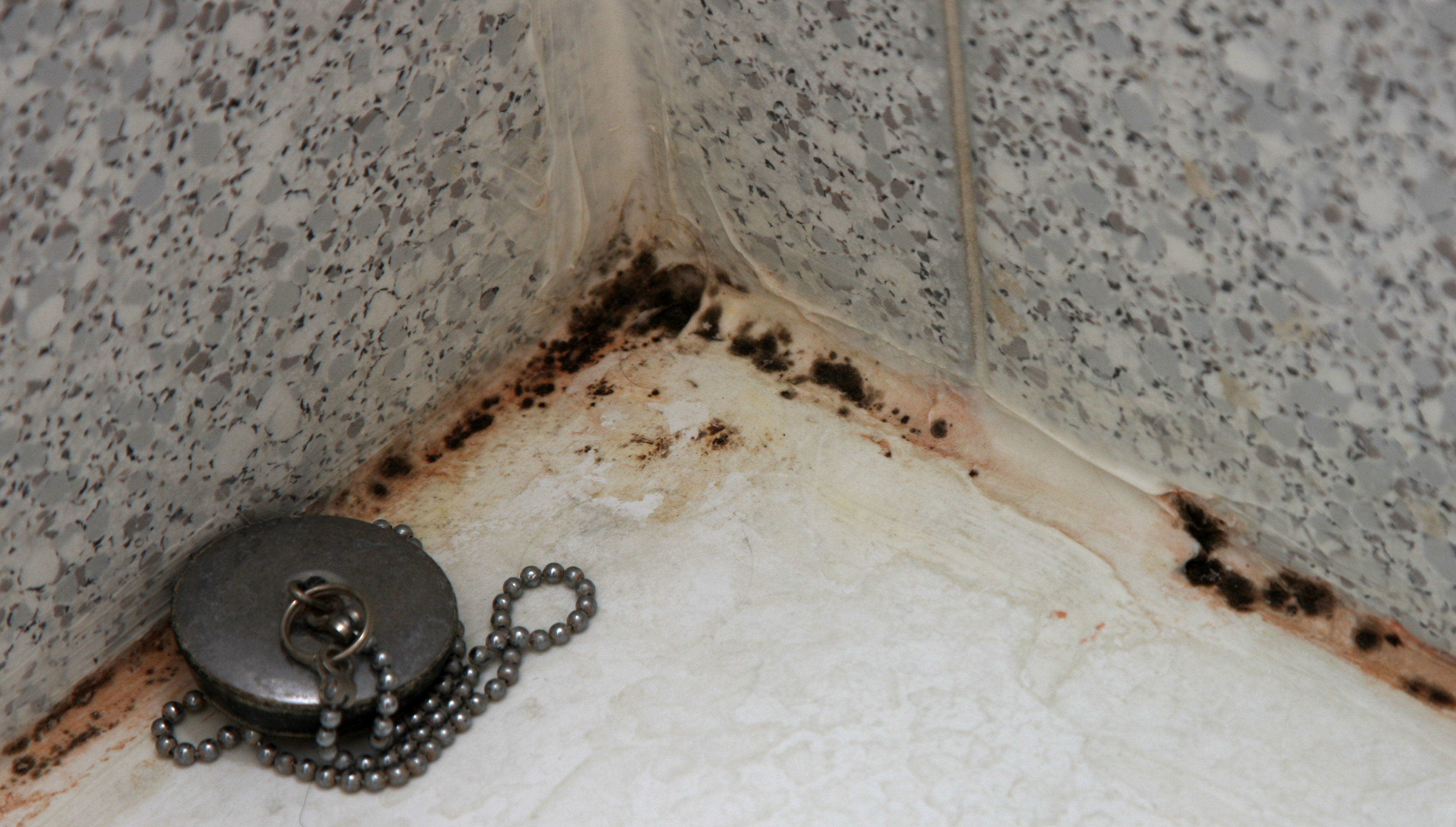 Mold in the corner of the room
Mold in the corner of the room Basically, fungal spots appear in places with increased accumulation of moisture. Be sure to thoroughly wipe everything during the cleaning process and check for mold spots.
Ways to get rid of mold
Of course, the best way to get rid of mold and fungus stains is to prevent them from appearing. But if nevertheless they appeared, then it is necessary to immediately begin to clean them.
The seams between tiles can be cleaned in many ways. But before processing, it is necessary to prepare special mixtures for purification. You can use the following products against mold stains:
- household chemicals, which include chlorine. Household chemicals include "Whiteness", "Domestos" and products that include chlorine. These mixtures are excellent helpers in the fight against mold. They not only remove it well, but also disinfect places. In the future, in places treated with chlorine-containing mixtures, mold spots do not appear;
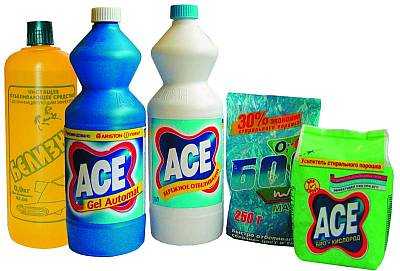 Household chemicals with chlorine
Household chemicals with chlorine - special antifungal type preparations designed to combat mold at home. One such remedy is Polymix. The composition of this mixture includes a microbiocide in the form of quaternary ammonium. The drug has a destructive effect on all kinds of fungi, mold, pathogenic bacteria and microorganisms;
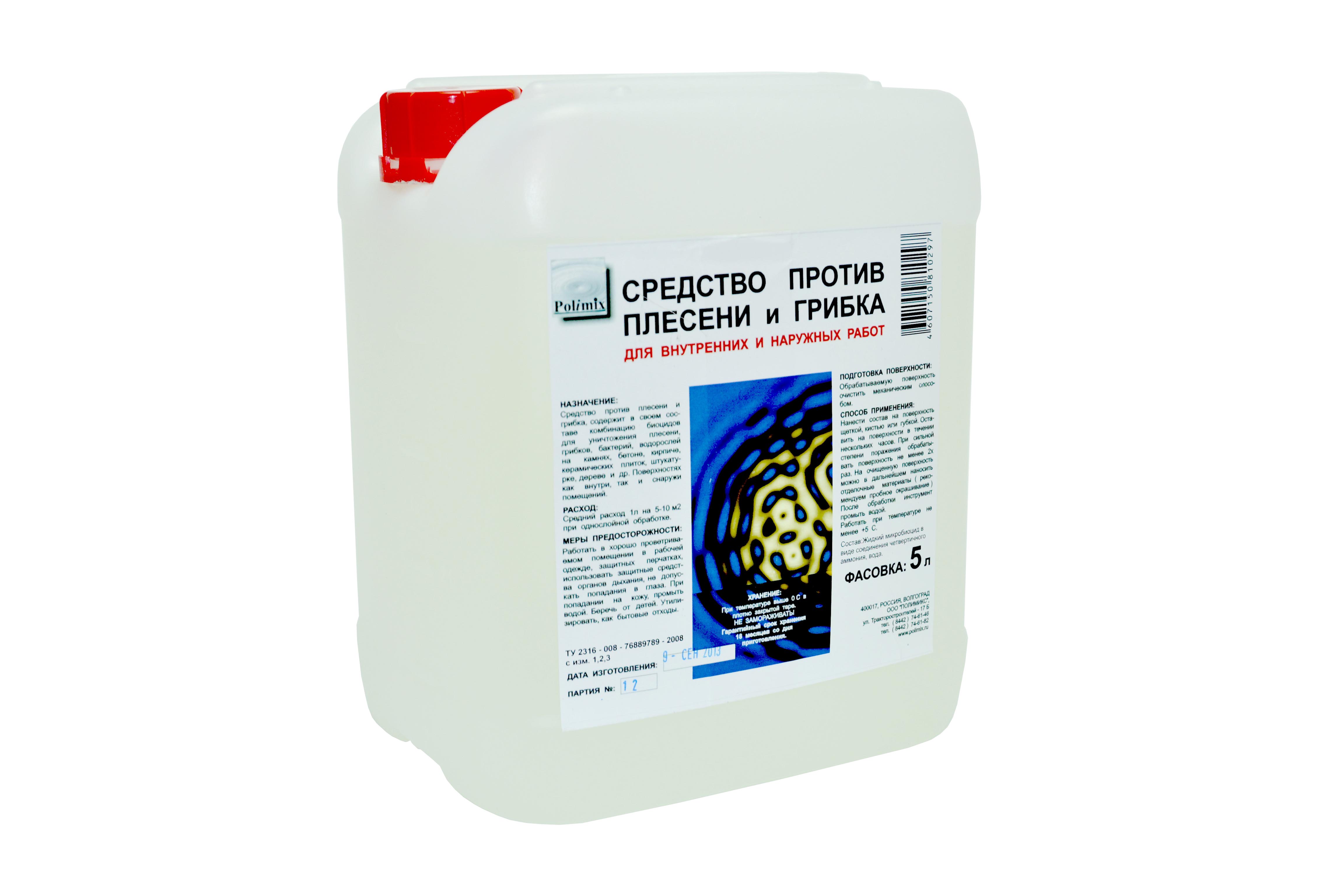 Polymix
Polymix - baking soda;
- alcohols and alcohol-containing compounds;
- antiseptic agents - hydrogen peroxide, potassium permanganate;
- products containing strong acids - acetic, oxalic;
- copper sulfate.
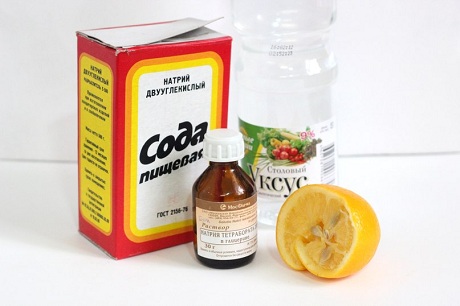 Folk remedies for mold
Folk remedies for mold Cleaning process
The cleaning agent has been selected, now it is worth preparing the necessary equipment for processing:
- to facilitate the work, the seams can be cleaned with a toothbrush. For these purposes, use an old unnecessary brush;
- rags for wiping;
- many products can have a harmful effect, it is better to use a respirator;
- rubber gloves can be used so that the skin of the hands does not suffer;
- container for dilution of the washing mixture;
- spray gun for spraying the mixture on tile seams with spots of fungus;
- sponge with hard surface;
- thin brush;
- bucket.
Let's get down to the process of processing the bathroom:
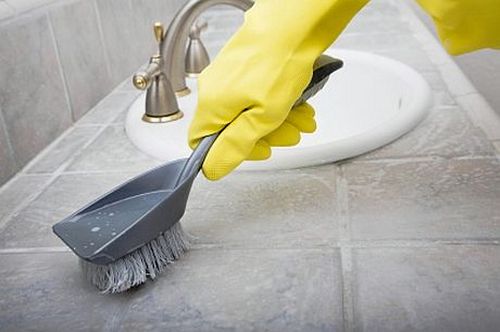
- to do this, it should be poured into a small cup;
- moisten the toothbrush a little with water and collect a little baking soda on the bristles;
- then you need to clean the seams of the tiled floor with a brush with soda. Cleansing is carried out until the stains are completely gone;
- alcohol means and antiseptic preparations; cleansing is carried out using a spray gun;
- the solution is sprayed on the seams and wiped with a cloth;
- You can get rid of mold stains with vinegar. Moreover, this tool can be found in everyone in the house;
- in the spray bottle you need to pour up to half the water and the same amount of acetic acid. Everything mixes well;
- the mixture must be sprayed onto the seams of the tiled walls in the bathroom;
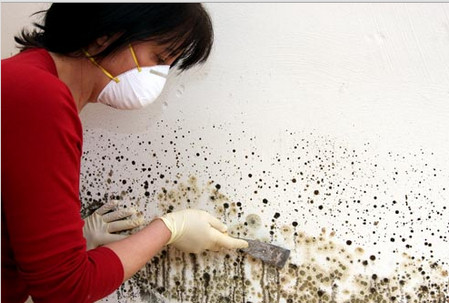 Be sure to use a respirator when cleaning mold from walls.
Be sure to use a respirator when cleaning mold from walls. - after a while, you need to clean the fungus with a brush or sponge;
- at the end, clean everything with water and a damp cloth;
- processing can be done using copper sulfate;
- for this, copper sulfate in the amount of 50 grams is poured into the bucket, 5 liters of water are poured;
- this mixture lubricates the places between the tiles. For lubrication, use a thin brush;
- leave the mixture for 2-3 hours. After that, we clean and rinse everything.
Replacement grout
Sometimes it is not possible to clean the mold with these products. Then you will have to make repairs, of course, you will not need to completely change the tile coating, but you will have to redo the seams.
How to do:
- if mold stains have appeared on the sealant and cannot be removed with special means, then they should be redone. First of all, we clean the mixture with a nail, spatula or other device;
- then you need to purchase a grease for joints with an antifungal and moisture resistant effect. It is desirable that it be sealed. The sealant does not allow moisture to pass through;
- the mixture is applied to the gaps of the tiled coating with a rubber spatula.
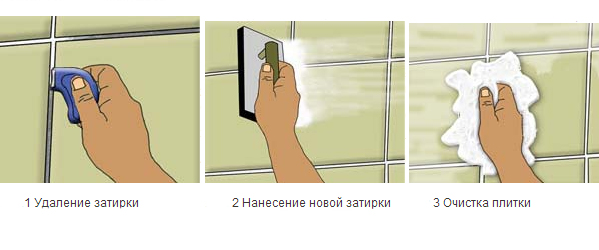 The sequence of actions when replacing the grout
The sequence of actions when replacing the grout Applying an alternative method
As an alternative to detergents and other preparations against fungus, there may be exposure using the microwave method. Many note that exposure to microwaves does not have a destructive effect on the finish, in addition, mold stains can be removed using this method.
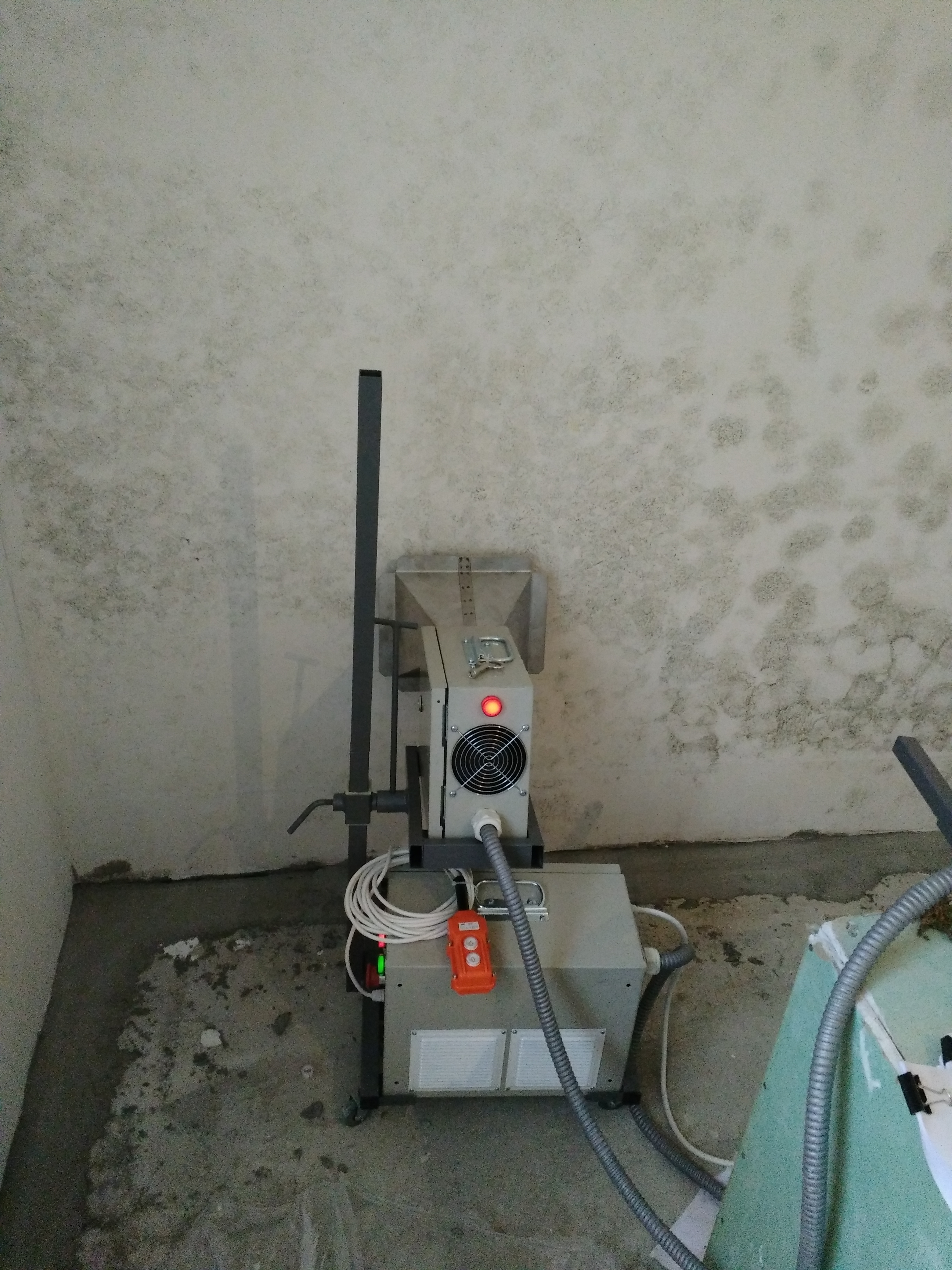 Removing mold with a microwave
Removing mold with a microwave The thing is that during the treatment, microwaves act pointwise, namely, only on the affected areas. This treatment is carried out using a special device that generates electromagnetic waves and creates vibrational processes of water molecules in microorganisms. These processes occur most intensively in places with high humidity. It is worth noting that fungal microorganisms consist of almost 90% water and as a result of this effect, their heating occurs faster, unlike finishing materials. All this ensures the rapid destruction of mold.
Further, this coating will protect against the appearance of mold spots and stroke. And the walls and appearance of the bathroom will always be beautiful. You can get rid of almost any fungus using this method. But before processing, you need to make a full check of the room for the presence of fungal stains.
Prevention
Getting rid of mold spots and fungus is very difficult and sometimes causes a lot of problems. Therefore, so that she does not disturb again, it is worth following the rules of prevention. They will help prevent the development of this trouble on the tiled floor in the bathroom:
- Initially, you need to determine the cause of the appearance of mold spots. Sometimes replacing the grout can solve this problem permanently. Use grout mixes on sealant. Fungal accumulations do not appear on the silicone coating;
- it is desirable to disassemble, clean the ventilation. It is better to install a fan from the side of the bathroom;
- do not dry a large amount of laundry in the bathroom, because it can create a high level of humidity in the room;
- the bathroom door should be kept constantly open so that air constantly enters the room;
- after taking a shower or bath, be sure to wipe the walls, plumbing and floor with a dry cloth;
- plumbing should be checked regularly for water leaks;
- be sure to monitor the condition of soap dishes, cups, because these things are breeding grounds for fungus. They should always be washed and without water;
- all possible joints should be treated with sealant so that water does not seep there;
- clean the bathroom periodically. It is necessary to wash the walls, the floor with water. You should also use detergents - powders, gels, whiteness. This will help prevent mold from reappearing.
- if iron pipes are installed in the room, then it is better to replace them with plastic ones. Usually, moisture accumulates constantly on iron products.
Get rid of mold and mildew in the bathroom not an easy task and it takes a lot of time and effort. To remove fungal accumulations in the bathroom, you can use various agents that have an antifungal effect. The main thing is to do everything right, then you can remove this problem completely and permanently.
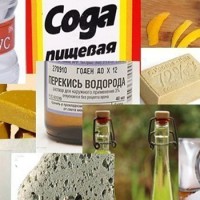
Mold in the bathroom on the tiles is a serious problem that affects not only the aesthetic appeal of the room, but also the health of the residents. To resolve it, they resort to the help of some chemical means, but for the most part - to the accumulated experience of the people. Moreover, black mold can occur on tiles in different places - on the surface or in the seams. And all because the most favorable conditions for progression are created in the bathroom. harmful microorganisms. The main reasons that a fungus develops on a tile are increased steam and moisture formation, poor ventilation, and sharp temperature fluctuations.
A factor such as the habitat of the fungus in the bathroom largely affects the choice of how to deal with it. What are these methods, and how to remove the fungus in the bathroom on the tile, it will become known further.
What is this article about
Fungus on bathroom tiles
If a fungus has appeared on the tiles in the bathroom or toilet, it will not be difficult to eliminate it. With sufficient ventilation, he can leave the room forever. But first clean the tiled surface. After degreasing, it is thoroughly dried. Then vinegar solution is applied to the tile. After the surface has completely dried, a strongly induced soda mixture is applied to it. Instead of vinegar, a chlorine composition, hydrogen peroxide or copper sulfate is suitable.
Please note: you can apply a liquid product by pouring it into a spray bottle. After 5 minutes, the product is washed off the walls.
When the soda gruel is applied to the tile, it is necessary to give a small margin of time for the mold and alkali to enter into an active interaction. A good solution is to carry out the procedure before nightfall. When the mold comes off the walls, it is necessary to rethink the situation and begin to eliminate the factors that provoke the reproduction of fungal spores. If possible, try to ventilate the room, provide an improved ventilation option in it, constantly wipe the ceramic surface dry after water procedures.
Blackness in the seam gaps
It is much more difficult to remove the blackness in the bathroom in the seams between the tiles. Initially, you should try to clean them with a soda solution and a used toothbrush.
What will be required:
- a screwdriver (or a similar tool with a “blade” working surface for the width of the seams);
- table vinegar, soda (sodium bicarbonate), chloride preparation (whiteness, for example);
- sandpaper;
- a toothbrush with hard bristles;
- narrow brush;
- grout.
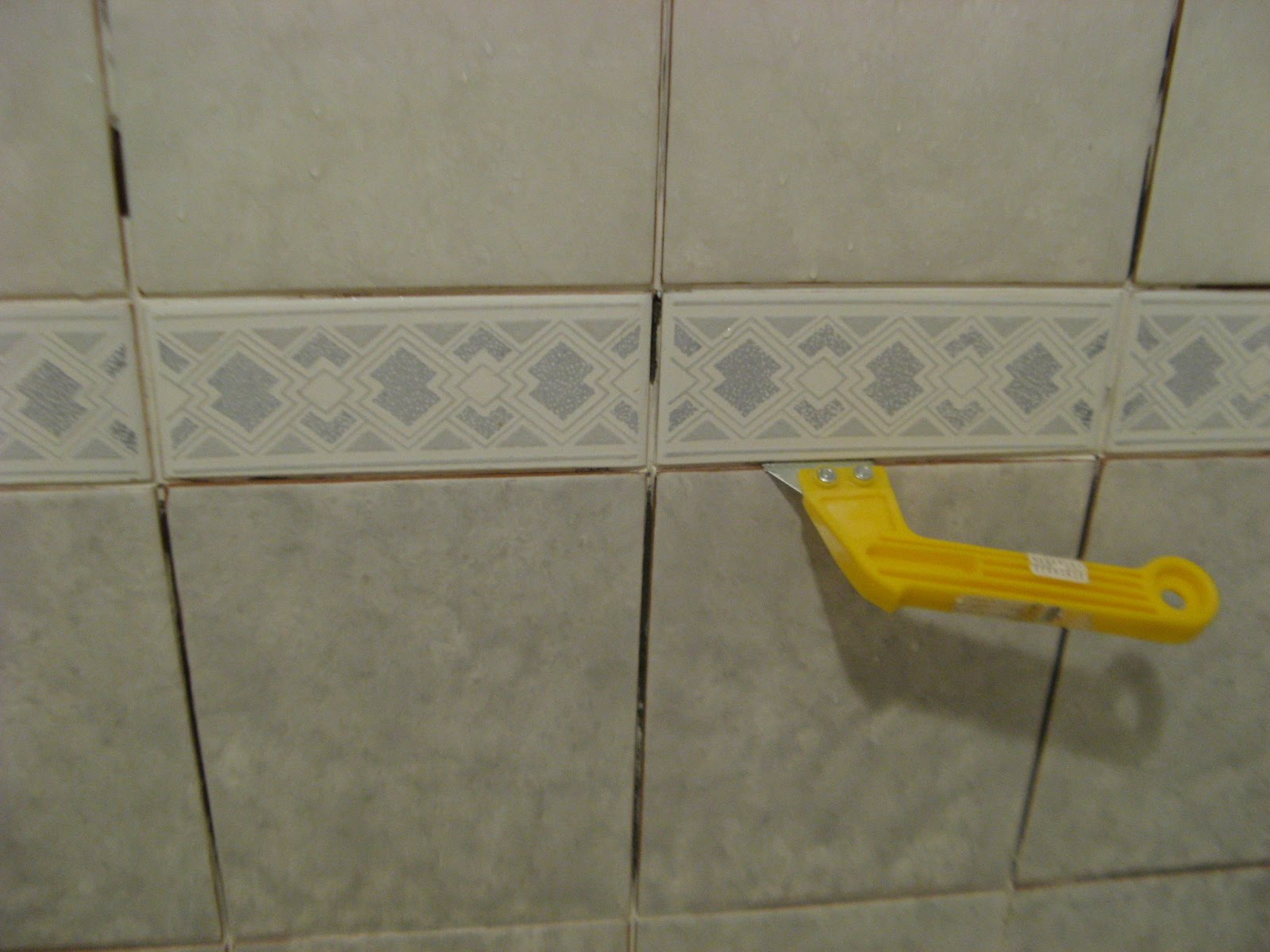
The procedure for removing blackness in the gaps between tiles can be carried out in different ways.
Seam cleaning methods
First way. Simple and fast. For him, they take ordinary soda and bleach or vinegar solution. To do this, a liquid bleach solution is passed along all the seams between the tiles, where there is blackness. Next, they wipe the previously treated places with a cloth (sponge), the composition should be completely washed off the walls. Fix the result by going through the same places with soda.
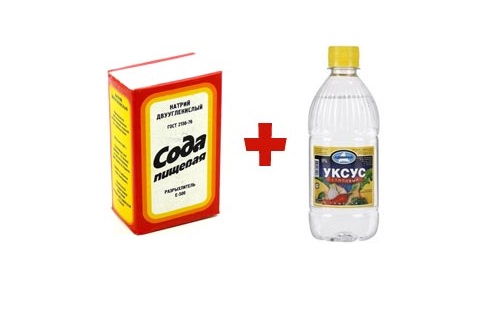
Second way. Sodium bicarbonate (ordinary soda) is taken and poured onto a flat dish. Taking a toothbrush, soak the bristles and dip in soda powder. Next, with a brush with soda, wipe the tile gaps. Then the treated seams are rinsed with water and wiped dry.
The first two methods really help to get rid of blackness. Six months - that's how long their shelf life can be. Therefore, repeated fungal infection of tiled surfaces in the bathroom is not ruled out. One who does not intend to experiment too long with different ways may choose more effective measures.
Third way. Tool, involving the use of a manual device - a screwdriver. Taking it in hand, they try to clean the entire layer of grout from the seams. Yes, the process is not easy. However, it is also the most effective, allowing you to eliminate mold on the grout without dismantling the tiles. Mechanically, with a little effort, it is possible to remove both the mold and its source. The method is dangerous. In addition, damage can be done to tiles. After opening the cracks, they are treated with vinegar, and after that they are again covered with a sealing fugue. At the same time, the grout must be selected one that includes both water-repellent and antiseptic substances.
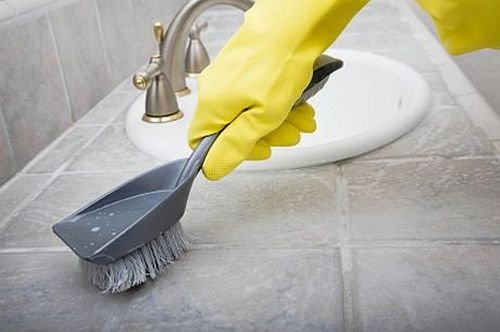
Chemistry against fungus on ceramics in the bathroom
Getting rid of the fungus on the tiles is facilitated not only by the above tools, which are always at hand for any caring housewife. This can be done through specialized preparations intended for these purposes.
Treatment with such preparations allows you to completely clean all surfaces in the room, including areas under sanitary and hygienic devices. However main task is to eliminate the causes of mold growth.
Before embarking on cleaning activities, it is necessary to study and strictly adhere to the rules for pre-treatment of surfaces. First, strong pollution is removed, then this place is dried with a building hair dryer. It is not recommended to turn on water during the processing procedure, because the air regime must be kept dry. The seams between the tiled elements are also subjected to careful treatment with antifungal agents.
Please note: when working on surface treatment with special chemicals, personal safety rules are always observed. The face is covered with a protective mask, hands - with rubber gloves. This is the only way to avoid harm from the use of active chemical compounds, contact with which in an enclosed space can hardly be avoided.
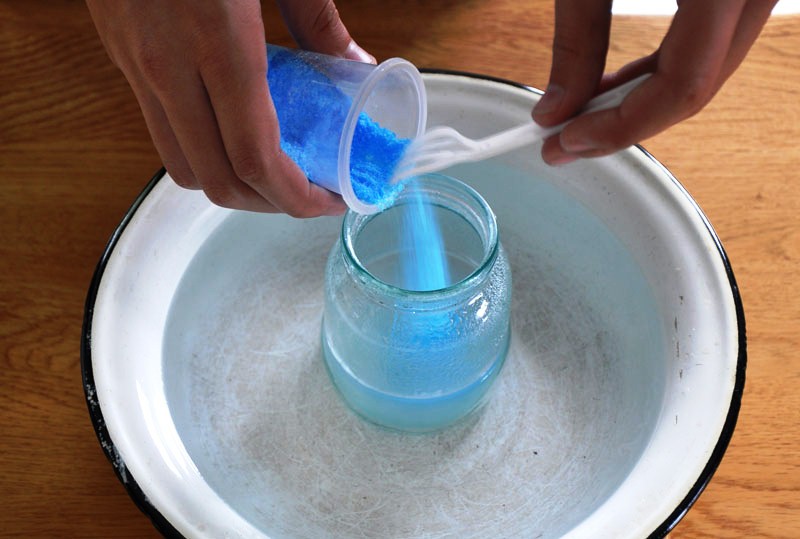
A solution of copper sulfate is used to remove mold in the toilet and bathroom directly from the tiles and from the seams. The toxicity of vitriol should be a warning in order to take safety measures. Instructions for use states that the product is mixed with water in a ratio of 100 to 10, that is, 100 g of the substance is poured into 10 liters of water. The tiled surface is treated with a solution in which the sponge is soaked. Vitriol is applied to the seams with a toothbrush or brush. In places of strong accumulation of blackness, the tool is passed repeatedly. Then wait a few hours and wash the base. The air in the room is ventilated.
Chlorine bleach is also an excellent mold remover. The substance does not require washing. After the procedure, the space is ventilated.
List of industrial preparations against mold:
- Renogal;
- PS 50;
- Titan Fungcide;
- impregnation "Snowball";
- Spectrum.
Many neglect the purchase of these specialized antifungal drugs, preferring more budget options (for example, copper sulfate). However, excessive passion for the latter can cost the landlord dearly. Since the use of copper sulfate, eliminating one type of fungus, can cause the development of another. In this connection, the most preferable option with the choice of a modern industrial tool.
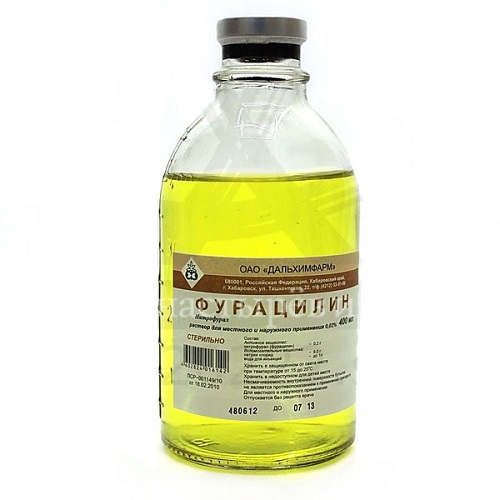
You can eliminate mold on the tiles in the bathroom by processing using furacilin. This tool has proven itself on the positive side in the fight against blackness. Why induce a furatsilin solution - 1 tablet per liter of water. Moreover, the drug is inexpensive and at the same time quite effective. Many who used it claimed that for a long time they forgot about what a fungal infection on the walls is.
Please note: spraying an antiseptic is possible only when there are no children living here, adult relatives and pets in the house. When mold develops in sanitary facilities, it is important not only to take measures to eliminate it, but to minimize all further opportunities for its occurrence. Enough common cause humid climate in the bathroom are pipes covered with condensate, leaking taps, damage to the waterproofing of drain devices or plumbing and other malfunctions with plumbing fixtures.
Professional tools will help solve the problem of blackness on the ceramic coating. Their packaging should clearly indicate that they destroy mold, and are not preventive drugs. The decision on whether to use such means, or can be dispensed with people's councils, everyone should accept, taking into account the specific situation.
Folk ways
In addition to official fungicides, folk ways to solve the problem are also largely effective. This method is especially suitable for those who, for one reason or another, cannot tolerate the use of chemicals.

For example, tea tree oil is a great option offered by the people. It is mixed with warm water. Processing is carried out using a sprayer. The composition does not need to be washed.
The composition of boric acid, iodine and tea tree oil has proven itself well. In addition, improvised means such as borax (dissolve a glass of powder in 1 liter of water), ammonia (with water the proportions are 1 to 1) are used for surface treatment.
However, the use of folk methods of struggle is only suitable when blackness has just begun to manifest itself on the tiled surface. If the fungus here is a habitual inhabitant, then it is better to resort to professional means, and even better - to the help of specialists.
Finding black mold in the bathroom of your own house or apartment is unpleasant for anyone. After all, those who at least once faced this problem know that the fight against it takes a lot of time and effort, and in especially difficult cases, money. But, it is impossible not to fight this phenomenon. After all, in addition to the fact that mold and fungus spoil the appearance of the room, they harm human health.
First of all, this is due to the fact that the products produced by the fungus in the process of life, which penetrate the human lungs, are highly toxic. I would like to note that the most prone to the formation of black mold in the apartment is the bathroom, which is constantly high humidity.
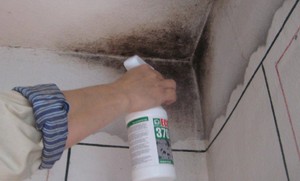
If one of the residents of the apartment begins to complain of a deterioration in well-being, accompanied by the appearance of rheumatic and headaches, subcutaneous rashes, coughing or vomiting, then a fungus or mold may be the cause of these symptoms.
Fungal mold releases spores into the air that cause health problems. That's why troubleshooting needs to be identified immediately and start fighting them. But first you need to figure out how to remove fungal growths on the walls in the bathroom? At the same time, the issue must be approached comprehensively in order to prevent the possibility of the reappearance of mold.
Causes of mold and mildew in the bathroom
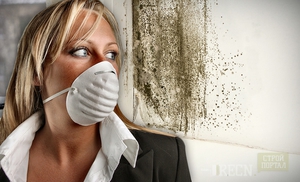 There are a lot of varieties of molds, but they are all conditionally divided into three types - blue fungi, molds and those formed during the process of decay. If we talk about the first subspecies, then its formation is possible only on a tree, so such a fungus does not threaten the bathroom. Also different kinds brown, white and bacterial rot are formed on wood and it is almost impossible to get rid of them.
There are a lot of varieties of molds, but they are all conditionally divided into three types - blue fungi, molds and those formed during the process of decay. If we talk about the first subspecies, then its formation is possible only on a tree, so such a fungus does not threaten the bathroom. Also different kinds brown, white and bacterial rot are formed on wood and it is almost impossible to get rid of them.
In the bathroom, first of all, you should be afraid of the mold form of the fungus, which, under conditions of high humidity, forms on a concrete or brick surface, as well as on paint or plaster. Sometimes black mold is skillfully disguised as a tile and in this case it will not work to visually identify the problem. Therefore, before starting to deal with the problem, need to find the root cause, which is:
- poor ventilation of the bathroom;
- low-power heated towel rail with poor heat dissipation;
- cast-iron sewer riser and water pipes on which condensate forms;
- water leakage in taps or water supply joints.
The presence of any of the factors considered, and even more so their combination, leads to optimal conditions for the development of fungal mold. And, as you know, in the bathroom there is always high humidity and heat contributing to the development of the problem, the consequences of which can be quite tangible.
There was a fungus in the bathroom - how to deal with the problem?
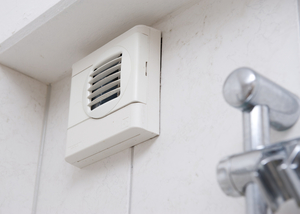 It is necessary to solve the problem of combating mold and fungus only with complex methods. To get rid of the fungus in the bathroom, simply removing it mechanically is not enough, as the mold can reappear. An integrated approach to the destruction of mold fungus should consist of certain stages that will lead to a qualitative result.
It is necessary to solve the problem of combating mold and fungus only with complex methods. To get rid of the fungus in the bathroom, simply removing it mechanically is not enough, as the mold can reappear. An integrated approach to the destruction of mold fungus should consist of certain stages that will lead to a qualitative result.
- Quality ventilation. Many people think that opening the door to the bathroom is enough to make the room dry. But in reality this is not the case and the use of an exhaust device is the only correct solution.
- We get rid of old furniture. This is primarily due to the fact that black mold spores accumulate on it, which penetrate deep into the material.
- Dealing with damp. The constant formation of condensate on the sewer riser is a consequence of its poor insulation. The faucet, the hose that brings water to the toilet and other bathrooms can leak, so they need to be put in good condition.
- High quality waterproofing. The use of moisture-resistant paint on most surfaces will prevent water from penetrating into finishing materials and furniture.
But the most difficult task is the direct removal of mold. At the same time, most of the time will be required for high-quality drying of the walls and ceiling, for which you need a good electric heater. Also on the degree of mold formation bathroom being refurbished various substances household chemicals. How to deal with fungus folk methods, time-tested, and modern household reagents.
Radical Methods
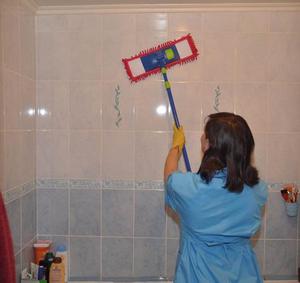 In order for the formation of a fungus or black mold to remain only an unpleasant memory, you need to approach the issue radically. In this case, the most effective way is considered to be a major overhaul. They remove tiles, wallpaper and get rid of paint on the walls and ceiling.
In order for the formation of a fungus or black mold to remain only an unpleasant memory, you need to approach the issue radically. In this case, the most effective way is considered to be a major overhaul. They remove tiles, wallpaper and get rid of paint on the walls and ceiling.
After complex preparatory work, all surfaces in the room are thoroughly dried with a building hair dryer or in another available way. However, during the repair it is strictly forbidden to use the bathroom for its intended purpose. But the most important question is how to get rid of the fungus in the bathroom completely and completely still remains relevant, because mold spores have already penetrated deeply into the materials used in the decoration of the room.
Therefore, without the help of special antiseptic reagents, for example, an antifungal primer sold in any hardware store is indispensable. As a last resort, chlorine bleach, copper sulfate, or a solution of water and laundry soap can be used to fight mold. After treating the surfaces of the room with such solutions, you can apply paint, whitewash or glue tiles or wallpaper.
Also on the advice of experts, in the fight against black mold in the bathroom ventilated doors help that are sold on the construction market. If the replacement of doors is not included in the homeowner's plans, then ventilation holes can be made in the old structure. At the same time, they can be easily decorated with a plastic mesh or any other available material.
How to remove fungus in the bathroom with household chemicals
 If with overhaul everything is clear, then how to remove mold in the bathroom without spending a lot Money, still needs to be clarified. I want to clarify right away that it’s not possible to simply use water with powder, as this leads to a short-term effect. It is possible to qualitatively and permanently remove black mold and fungus using certain means.
If with overhaul everything is clear, then how to remove mold in the bathroom without spending a lot Money, still needs to be clarified. I want to clarify right away that it’s not possible to simply use water with powder, as this leads to a short-term effect. It is possible to qualitatively and permanently remove black mold and fungus using certain means.
- A fairly effective way in the fight against fungus is the use of copper sulfate, which is relatively cheap and easy to use. But, at the same time, its toxicity must be taken into account and therefore you have to be careful when using it and wear rubber gloves and a respirator.
- Chlorine bleach or powdered chlorine also helps in the fight against mold in the bathroom. However, it has a significant disadvantage - a pungent odor, and therefore, when using it, it is necessary to ensure good ventilation of the room.
- Antiseptic reagents of industrial production, which are produced both on an oil basis and on alcohol or turpentine, do an excellent job of removing fungal growths in the bathroom.
- Ready-made household chemicals for mold removal effective method problem solving. In recent years, manufacturers of household chemicals are increasingly thinking about the problem of removing mold in rooms with high humidity. Therefore, they created a whole line of chemical reagents that destroy the fungus and other harmful formations.
Despite the fact that all household chemicals perfectly perform the functions assigned to them, they not recommended for use in apartments where there are people with respiratory problems, various allergic reactions to the components that make up household chemicals and a number of other diseases. Therefore, in such a situation, folk methods of removing mold are suitable.
Folk ways
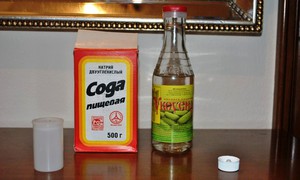 Before testing the remedies at hand, the extent of the problem should be assessed. Minor black spots will not cause any special problems, they are easily removed with a construction knife and a rag dipped in antiseptic. In the case of large foci that have grown to a significant size, more effort will be required.
Before testing the remedies at hand, the extent of the problem should be assessed. Minor black spots will not cause any special problems, they are easily removed with a construction knife and a rag dipped in antiseptic. In the case of large foci that have grown to a significant size, more effort will be required.
Creosote, made from tar, can be attributed to powerful aggressive agents that qualitatively remove fungus and mold. For many decades, it has been treated with railway sleepers and building structures to prevent rotting. Creosote is difficult to dissolve in water and therefore it is diluted with ethereal or alcohol-containing substances. Ingredients in Creosote harmful to human health and therefore it must be thoroughly washed off after use.
Another remedy that copes with the removal of minor fungal formations is ordinary vinegar, which is available in almost every kitchen. Thanks to the fact that this natural product he poses no danger for human health. The only disadvantage of vinegar is the unpleasant odor left after its use, however, and it quickly disappears. At the same time, to combat black mold with vinegar, there is a certain procedure:
- fill a spray bottle with vinegar or wet a rag with a solution;
- spray the composition on the affected area and wait until it dries completely;
- clean the surface with a hard-bristled brush;
- wash everything with water.
In addition to the solutions discussed above, the fungus in the bathroom can be removed with other folk remedies that are in almost any home:
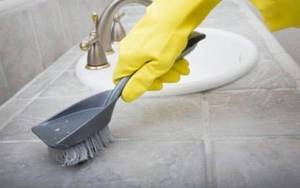
To the most dangerous folk remedies chlorine is involved, so when using it, you need to be as careful as possible and wear rubber gloves while ensuring good ventilation in the bathroom.
If you regularly maintain a normal microclimate in the bathroom and get rid of the slightest hint of mold or fungus in a timely manner, then the problem will never grow into a global scale. But, the most important thing is not to fight the fungus, but to prevent its occurrence. And for this, even at the stage of repairing the premises, you need to take care of installing good ventilation and heating systems.
